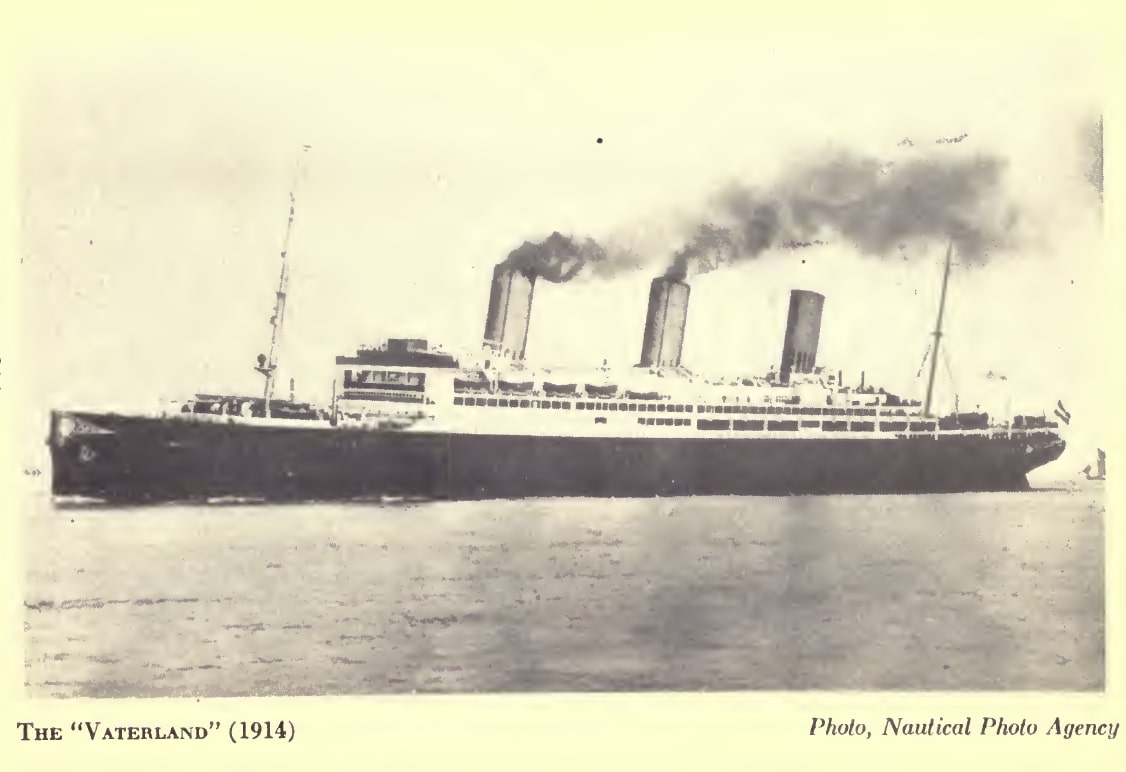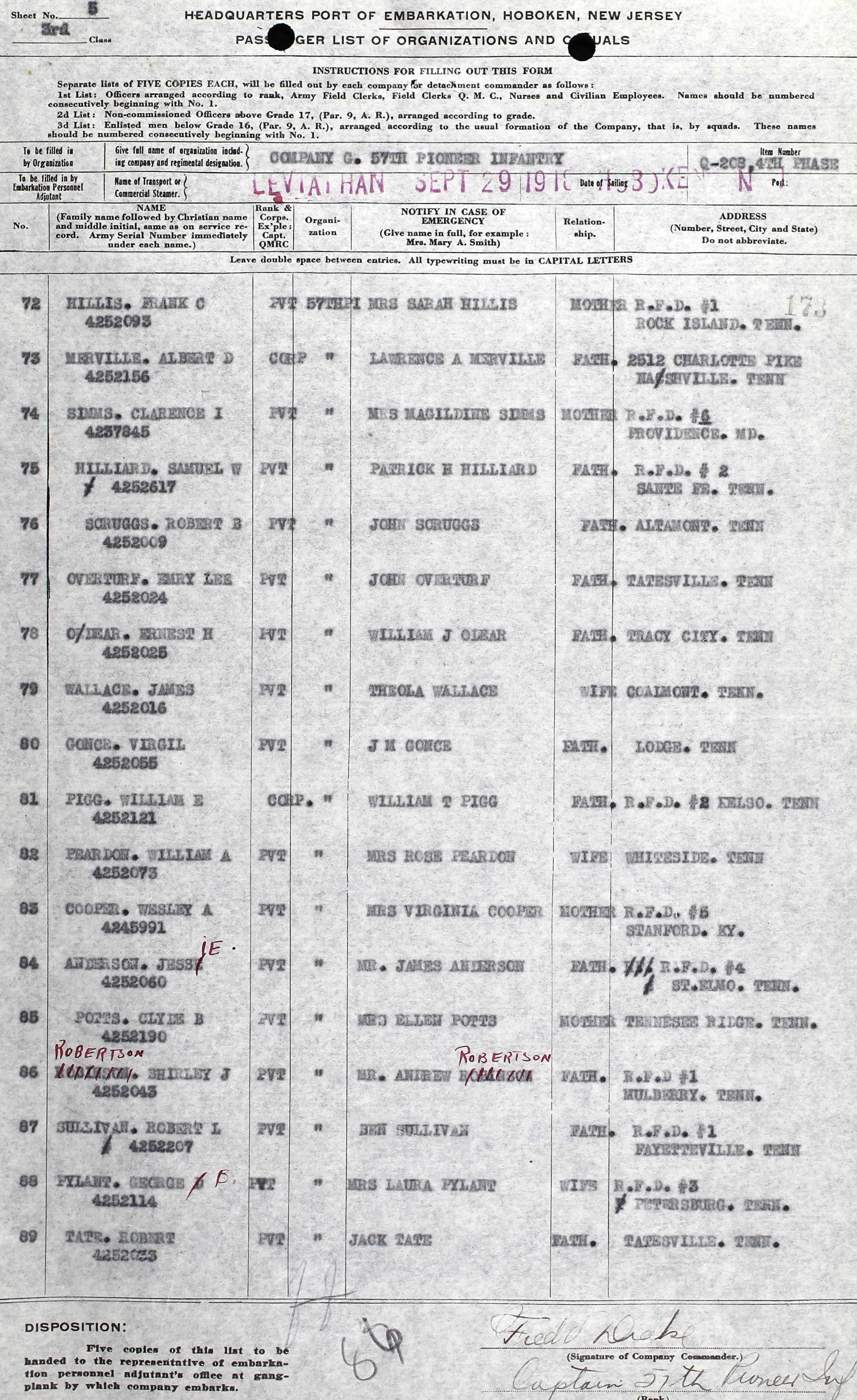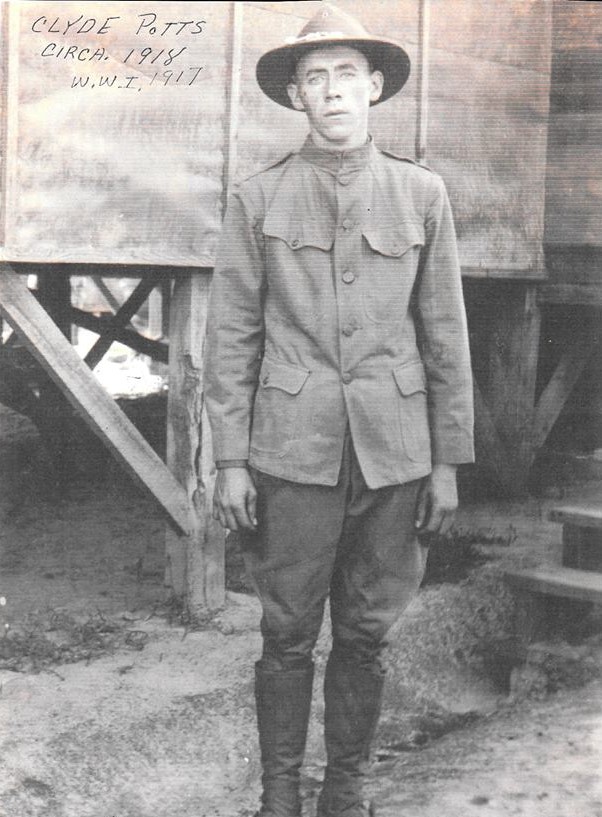In 1913, the German-owned Hamburg America Line launched a series of three steamships, each one larger than its predecessor. The first, the Imperator, was larger than the Titanic, which sank in the North Atlantic the year before. The Vaterland (“Fatherland” in German) was the second. It measured 290 meters (950 feet) in length and carried 54,282 tons of cargo. Third in the series, the Bismarck carried 300 tons more and was 2 meters (6 feet) longer.
 Image from Trans-Atlantic Passenger Ships Past and Present by Eugene W. Smith, Boston: George H. Dean Company, 1947, page 315
Image from Trans-Atlantic Passenger Ships Past and Present by Eugene W. Smith, Boston: George H. Dean Company, 1947, page 315
At the outbreak of war, the Imperator and the Bismarck were at port in Hamburg. The Vaterland was moored at Hoboken, New Jersey.
In the morning of April 6, 1917, the day the US declared war on the German Empire, American army troops seized the Vaterlund at its mooring in the Hoboken harbor. Within weeks, the ship was pressed into service as a troop transport, renamed the Leviathan.
 Clyde Brake Potts, the Leviathan, Hoboken, September 29, 1918
Clyde Brake Potts, the Leviathan, Hoboken, September 29, 1918
Where his brothers listed their father’s name as next of kin, the youngest boy gave Mrs. Ellen Potts, mother.
September 29, 1918, while his brothers Roy Albert and Benjamin Franklin fought in the Somme and the Meuse, Clyde Brake Potts, Company G, 57th Pioneer Infantry, boarded the Leviathan at Hoboken, New Jersey, bound for the war in Europe.
 Clyde Brake Potts in uniform with campaign hat, 1918
Clyde Brake Potts in uniform with campaign hat, 1918
In regulation use from as early as the 1870s, the campaign hat was standard issue to US Army soldiers throughout the Great War. However, its stiff, broad brim and four-cornered “Montana peak” made the felt headgear difficult to store when not needed. Upon entry into the war, the US Army adopted the narrow, creased cap from the French. The bonnet de police, made of soft cloth, could be folded over a belt.
In 1917 and early 1918, the cap was issued in France and, so, came to be known as the overseas cap. By mid-1918, the men exchanged their campaign hats for overseas caps at the Stateside port of embarkation. Therefore, in the photo, Uncle Clyde, who was drafted in late 1918, must be in the US, either, at Camp Wadsworth or at Camp Merritt.
At first the troops disdained the new and less aesthetic head cover. Though, as it was issued only to soldiers serving in Europe, the overseas cap, worn cocked to one side, became a symbol in which returning troops took pride.
My great grandfather, like many veterans, didn’t talk much about his wartime experience. His family has only his discharge paper and a few anecdotes.
One hundred years later, I’ve discovered a few documents that bear his name. From draft registration to discharge, I’m following the paper trail of B. F. Potts’s journey to the battlefields of the Great War in France and back home again.
Previous articles:
“Well, Daddy, what did you think about France?”
“It's a very muddy place.”
Benjamin Franklin Potts Registers for the Draft
As the Great War thundered across the fields of northern France, ten million American men, ages 21 to 30, signed their names to register to be drafted into military service.
Military Induction and Entrainment
“I, Benjamin Franklin Potts, do solemnly swear to bear true allegiance to the United States of America, and to serve them honestly and faithfully, against all their enemies or opposers whatsoever…”
“If it moves, salute it. If it doesn’t move, paint it!”
Embarkation, the Tunisian, and the Bridge of Ships
In his first ocean voyage, B. F. Potts crossed the submarine invested waters of the North Atlantic in a convoy of steamers escorted by a warship.
Enterprise, Tennessee: The Town That Died
Grandpa owned matched pairs of horses. Him and the boys [Ben and his brothers] cut and snaked logs out of the wood to the roads. He got a dollar a day plus fifty cents for the horses.
Rendezvous with the 35th Infantry Division
“Some of the guys disobeyed orders, went into the town, broke into a bakery, and stole all the bread and baked goods…”
The battle of Saint-Mihiel (September 12-15) would be Pershing’s first operation as army commander. He assigned the 35th to the strategic reserve, whose purpose is to replace a weakened unit or to fill any gap in the line created by the enemy.
“Private Potts, how tall are you?”
The soldier, looking into a button of the captain’s coat, says, “Five foot three, sir.” The wide brim raises.
On the front now, the 35th was in range of artillery fire, and enemy planes made nighttime bombing raids over the countryside.
Planning the Meuse-Argonne Offensive
On the left, the 137th would take the “V of Vauquois,” a formidable network of trenches, zig-zagging from the hill’s west flank to the village of Boureuilles, a mile away.
The gun jumps, the earth shudders, a shock wave shatters the air and accompanies a roar that bursts between the ears. Powder fumes permeate the air. Explosions count seconds across unending darkness.
…up until 7:40 a.m. when the rolling barrage ceased, we can follow Private Potts’s movement across the battlefield.
Scrawling in a notepad, the commander tears the sheet, folds it, and thrusts it into the runner’s hands.
“Potts, take this message to brigade. Tell them we need artillery now. Go!”
“Let him lie in an artillery shower all night, if you must. But do not disturb a soldier’s sleep, sir, with your orders that change from one minute to the next!”
By morning’s end, the intermingled 137th and 139th regiments gained 500 meters and dug in before Montrebeau Wood. Through the woods and German machine-gun nests and sniper fire, the men fought in the afternoon.
“When I asked him [Grandpa Ben] if he killed anyone, this is what he told me…”
As the men would destroy one machine-gun nest, other enemy gun crews were setting up on both sides of their skirmish line.
Next date:
September 30—The Engineers’ Line